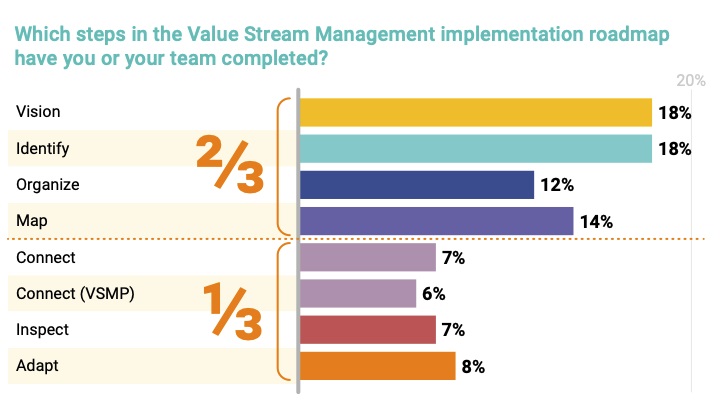GitLab announced the general availability of GitLab Duo with Amazon Q.
The Value Stream Management Consortium recently released our latest annual report, The State of Value Stream Management 2022(link is external). This year's report provides the latest adoption trends in the value stream management market.
Key findings in the 2022 report include:
■ A 16% increase in respondents piloting or implementing Value Stream Management Platforms (VSMP) since the last report (July 2021)
■ 10% increase in respondents aligning to explicitly named value streams
■ 6% increase in respondents measuring organizational outcomes
■ Aggregating through a dashboard to obtain data about value stream flow is the most popular method, despite a 7% decrease in the practice
Our second round of research compares this year to last year in a unique way representing the flux of changes, advances, the challenges, and opportunities within Value Stream Management. Every company which has products or customers has value streams. Nonetheless, these value streams must be first described and understood and then optimized across the owners to improve funding, budgeting, and outcomes.
As new initiatives (digital or non-digital) require changes and/or new products and services, VSM significantly enriches collaboration and aligns the various teams across both business and technology. It should be part of any product and service strategy. We have seen a growth in adoption but there is still plenty of room to reach its full potential.
We have researched and are reporting data which indicate the extent of organizations' VSM adoption, as well as the nature of their organizations, platforms, and challenges as they move through the VSM implementation roadmap. When we first published this roadmap in 2021, we were pleased to see that it sparked a debate around the potential for rearranging these steps. Broadly, we've chosen to present the steps here according to the well-established industry adage of people > process > tools.
A counter-example some have suggested is that teams can start connecting the parts of their DevOps toolchains before fully organizing, or mapping the value stream. We have observed real-life success-cases using this approach. Our hypothesis is that this is a viable quick-start in close-knit organizations, and we intend to explore this in future research.

Click on the image above for a larger version
We asked survey respondents which of the steps in the implementation map they had completed. 25% of respondents have not completed any steps. The first step— to set the long term vision and goals—is the most likely to be completed. Fewer respondents have started organizing around value streams yet, but there is a spike for mapping value streams, across the otherwise broadly downward trend across the implementation roadmap. This is unsurprising, since value stream mapping is most teams' and organizations' gateway into value stream management, thanks to its popularity as a practice in both lean and DevOps.
Experience with connecting the DevOps toolchain, in alignment to the organization's value streams is more than twice as rare as experience with mapping, and use of a VSM platform (VSMP) to do this is rarer still. Finally, respondents were less likely to be inspecting their value streams than actively adapting them.
In an ideal world, everyone would have equal experience along every step along the roadmap, but currently there is a drop-off as we progress along the steps. Broadly speaking, people fall into one of two large groups: those who have experience with vision, identification, organization and mapping (circa 2⁄3); and those who have experience connecting, inspecting and adapting the value stream (circa 1⁄3).

VSM is crossing the chasm. Our research highlights key findings along the VSM implementation journey, and shows that while organizations have engaged in the vision and identification phases, there is more work to be done. We have seen no decline in the interests and use of value stream mapping, but challenges arise from lack of skills, understanding, and leadership support. The most compelling insight: leaders need help to chart their path of understanding, adopting, and practicing the art of VSM.
Industry News
Perforce Software and Liquibase announced a strategic partnership to enhance secure and compliant database change management for DevOps teams.
Spacelift announced the launch of Saturnhead AI — an enterprise-grade AI assistant that slashes DevOps troubleshooting time by transforming complex infrastructure logs into clear, actionable explanations.
CodeSecure and FOSSA announced a strategic partnership and native product integration that enables organizations to eliminate security blindspots associated with both third party and open source code.
Bauplan, a Python-first serverless data platform that transforms complex infrastructure processes into a few lines of code over data lakes, announced its launch with $7.5 million in seed funding.
Perforce Software announced the launch of the Kafka Service Bundle, a new offering that provides enterprises with managed open source Apache Kafka at a fraction of the cost of traditional managed providers.
LambdaTest announced the launch of the HyperExecute MCP Server, an enhancement to its AI-native test orchestration platform, HyperExecute.
Cloudflare announced Workers VPC and Workers VPC Private Link, new solutions that enable developers to build secure, global cross-cloud applications on Cloudflare Workers.
Nutrient announced a significant expansion of its cloud-based services, as well as a series of updates to its SDK products, aimed at enhancing the developer experience by allowing developers to build, scale, and innovate with less friction.
Check Point® Software Technologies Ltd.(link is external) announced that its Infinity Platform has been named the top-ranked AI-powered cyber security platform in the 2025 Miercom Assessment.
Orca Security announced the Orca Bitbucket App, a cloud-native seamless integration for scanning Bitbucket Repositories.
The Live API for Gemini models is now in Preview, enabling developers to start building and testing more robust, scalable applications with significantly higher rate limits.
Backslash Security(link is external) announced significant adoption of the Backslash App Graph, the industry’s first dynamic digital twin for application code.
SmartBear launched API Hub for Test, a new capability within the company’s API Hub, powered by Swagger.
Akamai Technologies introduced App & API Protector Hybrid.




